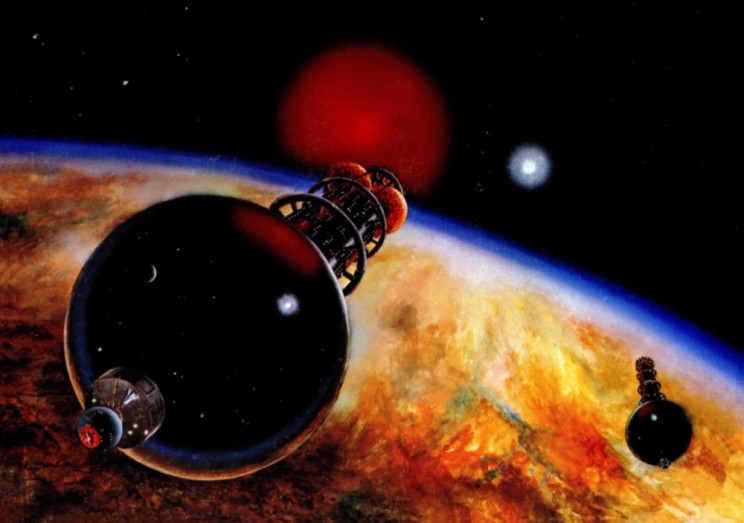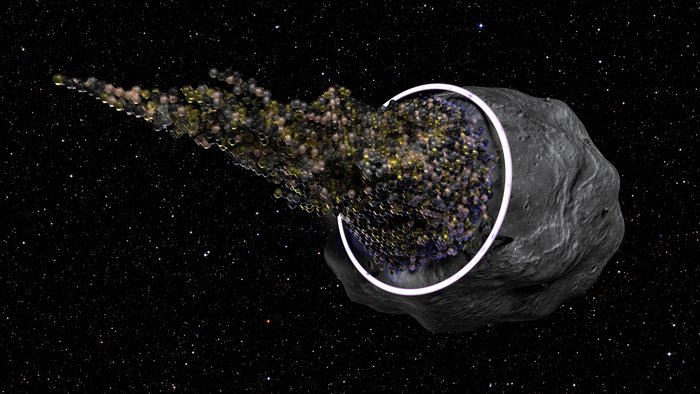The dream of traveling to another star and planting the seed of humanity on a distant planet… It is no exaggeration to say that it has captivated the imaginations of human beings for centuries. With the birth of modern astronomy and the Space Age, scientific proposals have even been made as to how it could be done. But of course, living in a relativistic Universe presents many challenges for which there are no simple solutions.
Of these challenges, one of the greatest has to do with the sheer amount of energy necessary to get humans to another star within their own lifetimes. Hence why some proponents of interstellar travel recommend sending spacecraft that are essentially miniaturized worlds that can accommodate travelers for centuries or longer. These “Generation Ships” (aka. worldships or Interstellar Arks) are spacecraft that are built for the truly long haul.
The logic behind a generation ship is simple: if you can’t travel fast enough to get to another star system within a single lifetime, build a vessel large enough to carry everything you would possibly need for a long voyage. This would entail making sure that a ship has a reliable propulsion system that can provide steady thrust during acceleration and deceleration and the necessary amenities to provide for several generations of humans.
On top of all that, the ship would need to be able to ensure that its crews had food, water, and breathable air – enough to last for centuries or even millennia. In all likelihood, this would mean creating a closed-system microclimate inside the ship, complete with a water cycle, a carbon cycle, and a nitrogen cycle. This will allow for food to be grown and for water and air to be continuously recycled.
Reaching the Nearest Stars
The closest star to our Solar System is Proxima Centauri, an M-type (red dwarf) main sequence star located roughly 4.24 light-years away. This star is part of a triple star system that includes the Alpha Centauri system, a binary consisting of a main sequence Sun-like star (a G-type yellow dwarf) and a main sequence K-type (orange dwarf) star.
In addition to being the closest star system to our own, Proxima Centauri is also the home of the closest exoplanet to Earth – Proxima b. This terrestrial (aka. rocky) planet – whose discovery was announced in 2016 by the European Southern Observatory (ESO) – is about the same size as Earth (1.3 Earth masses) and orbits within the circumsolar habitable zone of its star.
The next closest exoplanet that orbits within its star’s HZ is Ross 128 b, an Earth-sized exoplanet that orbits a red dwarf star some 11 light-years away. The next closest Sun-like star is Tau Ceti, which is just under 12 light-years away and has one potentially-habitable candidate (Tau Ceti e). In fact, there are 16 exoplanets within 50 light-years of Earth that could support life.

But as we explored in a previous article, traveling to even the nearest star would take a very long time and require a tremendous amount of energy. Using conventional means of propulsion, it could take between 19,000 and 81,000 years to get there. Using proposed methods that have been tested but not yet built (like nuclear rockets), the travel time is narrowed to about 1000 years.
There are proposed methods that are capable of reaching the nearest stars within a single lifetime, such as directed-energy propulsion – for example, Breakthrough Starshot. For this concept, a light sail and gram-scale spacecraft could be accelerated to 20% of the speed of light (0.2 c), thus making the journey to Alpha Centauri in just 20 years. However, Starshot and similar proposals are all uncrewed concepts.
Beyond this, the only possible methods for sending human beings to another star system are either technically feasible (but undeveloped) or entirely theoretical (like the Alcubierre Warp Drive). With that in mind, many scientists have drafted proposals that would forsake speed and instead focus on accommodating crews during the long voyage.
Examples In Fiction
The earliest recorded example appears to have been made by engineer and science fiction writer John Munro in his novel A Trip to Venus (1897). In it, he mentions how humanity may become an interstellar species one day:
“[W]ith a vessel large enough to contain the necessaries of life, a select party of ladies and gentlemen might start for the Milky Way, and if all went right, their descendants would arrive there in the course of a few million years.”

The concept was addressed in more detail in the 1933 science fiction novel When World Collide, which was co-authored by Philip Wylie and Edwin Balmer. In this story, Earth is about to be destroyed by rogue planets passing through the Solar System. This forces a group of astronomers to create a massive ship carrying a crew of 50, along with livestock and equipment, to a new planet.
Robert A. Heinlein also explored the physical, psychological and social effects of a generation ship in one of his earliest novels, Orphans of the Sky. The story was originally published as two separate novellas in 1941 but was re-released as a single novel in 1963. The ship in this story is known as the Vanguard, a generation ship that is permanently adrift in space after a mutiny led to the deaths of all the piloting officers.
Generations later, the descendants have forgotten the purpose and nature of the ship and believe it to be their entire Universe. The bulk of the crew still lives within the cylinder, but a separate group of “muties” (which alternately means they are mutants or mutineers) live in the upper decks where the gravity is lower, and exposure to radiation has caused physical changes.
Arthur C. Clarke’s Rendezvous with Rama (1973) is arguably the best-known example of a generational ship in science fiction. Unlike other fictional treatments of the concept, the vessel in this story was extra-terrestrial in origin! Known as Rama, this massive space cylinder is a self-contained world that is carrying the “Ramans” from one side of the galaxy to the other.
The story opens as a crew from Earth is dispatched to rendezvous with the ship and explore the interior. Inside, they find structures arranged like cities, transportation infrastructure, a sea that stretches around the center, and horizontal trenches that act as windows. As the ship gets closer to the Sun, light floods in, and the machinery begins to come to life.
Eventually, the human astronauts conclude that the buildings are actually factories and that the ship’s sea is a chemical soup that will be used to create “Ramans” once it reaches its destination. Ultimately, though, our Solar System is just a stopover on their journey, and this is how the Ramans seed the galaxy with their species.
In Alastair Reynold’s Chasm City (2001) – which is part of his Revelation Space series – much of the story takes place aboard a series of large, interstellar spacecraft. These ships are traveling to 61 Cygni, a binary star system consisting of two K-type orange dwarfs, to colonize a world that is known throughout the series as Sky’s Edge.
These ships are described as cylindrical and rely on antimatter propulsion to travel at relativistic speeds. In addition to carrying a complement of cryogenically frozen passengers, these ships maintain a crew in waking conditions and have all the necessary facilities and equipment to keep them entertained. These include personal quarters, mess halls, medical bays, and recreation centers.
In 2002, famed science fiction author Ursula K. LeGuin released her own take on the effects of inter-generational space travel, titled Paradises Lost. The setting for this story is the Discovery, a ship that has been traveling through space for generations. As those who remember Earth begin to die off, the younger generations begin to feel like the ship is more tangible to them than either the lore about their old homeworld or their destination.
Eventually, a new religion emerges called “Bliss” that teaches that the Discovery (“spaceship heaven” to the faithful) is actually bound for eternity rather than another planet. This religion is being embraced to the dismay of the older generation, who fear their children will never want to leave the ship once it arrives. This story was adapted into an opera in 2012 as well.
The 2011 novel Leviathan Wakes by James S. A. Corey (and subsequent installments in the Expanse series) features a generation ship named “Nauvoo.” This vessel is being built by a group of Mormons, so they can travel to another star system and colonize there. The Nauvoo is described as being massive, cylindrical in shape, and rotates to generate artificial gravity for its crew.
In Kim Stanley Robin’s Aurora (2015), the majority of the story takes place aboard an eponymously-named interstellar starship. Robinson describes a vessel that uses two rotating torii to simulate gravity while the people live in a series of Earth-analog environments. Their ultimate destination is Tau Ceti, a Sun-like star located 12 light-years from Earth, where they intend to colonize an exomoon that orbits Tau Ceti e.
The ship is described as an Orion-class vessel that uses the controlled explosion of thermonuclear devices to generate propulsion, along with an electromagnetic array used to launch it from the Solar System. In Robinson’s signature style, considerable attention is also dedicated to how the colonists maintain a careful balance aboard their vessel and the psychological effects of multi-generational travel.
Proposals
Multiple proposals have been made by scientists and engineers since the early 20th century. Many of these proposals were presented in the form of studies, while others were popularized in science fiction novels. The earliest known example was the 1918 essay “The Ultimate Migration” by rocket-pioneer Robert H. Goddard (for whom NASA’s Goddard Space Flight Center is named).
The crew would spend the centuries-long journey in suspended animation, with the pilot being awakened at intervals to make course corrections and maintenance. As he wrote:
“The pilot should be awakened, or animated, at intervals, perhaps of 10,000 years for a passage to the nearest stars, and 1,000,000 years for great distances, or for other stellar systems. To accomplish this, a clock operated by a change in weight (rather than by electric charges, which produce too rapid effects) of a radiation substance, should be used… This awakening would, of course, be necessary in order to steer the apparatus, if it became off its course.”
He also envisioned that atomic energy could be used as a power source. But failing that, a combination of hydrogen and oxygen fuel, as well as solar energy, would suffice. Based on his calculations, Goddard estimated that these would be sufficient to get the ship up to speeds of 4.8 to 16 km/s (3 to 10 mi/s), which works out to 17,280 km/h to 57,600 km/h (10,737 to 36,000 mph) or 0.000016% to 0.00005% the speed of light.
Konstantin E. Tsiolkovsky, the “father of astronautic theory,” also addressed the idea of a multi-generational spaceship in his essay “The Future of Earth and Mankind” (1928). Tsiolkovsky described a space colony (a “Noah’s Ark”) that would be self-sufficient and where crews were kept in wakeful conditions until they reached their destination thousands of years later.
Another early description of a generation ship is in the 1929 essay “The World, The Flesh, & The Devil” by J. D. Bernal (inventor of the “Bernal Sphere”). In this influential essay, Bernal wrote about human evolution and its future in space, which included vessels that we would today describe as “generation ships.”
In 1946, Polish-American mathematician Stanislaw Ulam proposed a novel idea known as Nuclear Pulse Propulsion (NPP). As one of the contributors to the Manhattan Project, Ulam envisioned how nuclear devices would be repurposed for the sake of space exploration. In 1955, NASA launched Project Orion for the purpose of investigating NNP as a means for conducting deep-space voyages.

This project (which officially ran from 1958 to 1963) was led by Ted Taylor at General Atomics and physicist Freeman Dyson from the Institute for Advanced Study in Princeton, New Jersey. It was abandoned after the Limited Test Ban Treaty (signed in 1963) established a permanent ban on nuclear testing in Earth orbit.
In 1964, Dr. Robert Enzmann proposed the most detailed concept for a generation ship to date, thereafter known as the “Enzmann Starship“. His proposal called for a ship that would use deuterium fuel to generate fusion reactions to achieve a small percentage of the speed of light. The craft would measure 600 meters (2000 feet) in length and accommodate an initial crew of 200 (with room for expansion).
During the 1970s, the British Interplanetary Society conducted a feasibility study for interstellar travel known as Project Daedalus. This study called for the creation of a two-stage fusion-powered spacecraft that would be able to make the trip to Barnard’s Star (5.9 light-years from Earth) in a single lifetime. While this concept was for an uncrewed spacecraft, the research would inform future ideas for crewed missions.
For example, the international organization Icarus Interstellar has since attempted to revitalize the concept in the form of Project Icarus. Founded in 2009, Icarus’ volunteer scientists (many of whom have worked for NASA and the ESA) hope to make fusion propulsion and other advanced propulsion methods a reality in the 21st century.

Studies have also been conducted that have considered antimatter as a means of propulsion. This method would involve colliding atoms of hydrogen and antihydrogen in a reaction chamber, which offers the benefits of incredible energy density and low mass. For this reason, NASA’s Institute for Advanced Concepts (NIAC) is researching the technology as a possible means for long-duration missions.
Between 2017 and 2019, Dr. Frederic Marin of the Astronomical Observatory of Strasbourg conducted a series of highly-detailed studies on the necessary parameters for a generation ship – including minimum crew size, genetic diversity, and the size of the ship. In all cases, he and his colleagues relied on a new type of numerical software (called HERITAGE) that they created themselves.
For the first two studies, Dr. Marin and his colleagues conducted simulations that showed that a minimum crew of 98 (max. 500) to be coupled with a cryogenic bank of sperm, eggs, and embryos in order to ensure survival (but avoid overcrowding) as well as genetic diversity and good health upon arrival.
In the third study, Dr. Marin and another team of researchers determined that a generation ship would need to measure 320 meters (1050 feet) in length, 224 meters (735 feet) in radius, and contain at least 450 m² (~4,850 ft²) of artificial land for the sake of agriculture. This land would also ensure that the ship’s water and air would be recycled as part of a microclimate.

Advantages
The main advantage of a generation ship is the fact it can be built using proven technology and will not have to wait on considerable advancements in technology. Also, the central aim of the concept is to forego the issue of speed and propellant mass to ensure that a crew of human beings can eventually colonize another star system.
As we explored in a previous article, a generation ship would also fulfill two major goals of space exploration, which are to maintain a human colony in space and permit travel to a potentially habitable exoplanet. On top of that, a crew that numbers in the hundreds or thousands would multiply the chances of successfully colonizing another planet.
Last, but not least, the spacious environment of a generation ship would allow for multiple methods to be pursued. For example, part of the crew could be kept in waking conditions for the duration of the journey, while another part could be kept in cryogenic suspension. People could also be revived and return to suspension in shifts, thus minimizing the psychological effects of the long-duration journey.
Unfortunately, that’s where the advantages end and the problems/challenges begin.
Disadvantages
The most obvious disadvantage of a generation ship is the sheer cost of constructing and maintaining such large spaceships, which would be prohibitive. There are also the dangers of sending human crews into deep space for such extended periods of time. On a voyage that would take centuries or millennia, there is the distinct possibility that the crew will succumb to feelings of isolation and boredom and turn on each other.
Then there are the physiological issues that a multi-generational journey through space could entail. It is well-known that the radiation environment in deep space is significantly different than the environment on Earth or in low Earth orbit (LEO). Even with radiation shielding, long-term exposure to cosmic rays could have a serious impact on crew health.
While cryogenic suspension could help mitigate some of these issues, the long-term effects of cryogenics on human physiology is not yet known. This means that extensive testing would be needed before such a mission could ever be attempted. This only adds to the overall moral and ethical considerations that this concept entails.
Last, there is the possibility that subsequent technological progress will lead to the development of faster and more advanced starships in the meantime. These ships, departing Earth much later, could be able to overtake the generation ship before it ever reached its destination – thus making the entire journey pointless.

Conclusions
Given the sheer cost of building a generation ship, the risks of making such a long journey, the number of unknowns involved, and the possibility that it would be rendered pointless by the advancement of technology, one has to ask the question: is it worth it? Unfortunately, like so many questions pertaining to multi-generational space travel, there is no clear answer.
In the end, if the resources are available and the will to do it is there, human beings may very well attempt such a mission eventually. There will be no guarantee of success, and even if the crew successfully makes it to another star system and colonizes a distant planet, it will be millennia before anyone on Earth hears from their descendants.
Under the circumstances, it would seem more sensible to just wait on further technological advances and try to go interstellar later. However, not everybody may not be so willing to wait, and history tends to remember those who defy the odds and take risks. And as ventures like Mars One have shown us, there is no shortage of people willing to risk their lives for the sake of colonizing a distant world!
We have written many articles on the subject of Generation Ships here at Universe Today. Here’s What’s the Minimum Number of People you Should Send in a Generational Ship to Proxima Centauri? and How Big Would a Generation Ship Need to be to Keep a Crew of 500 Alive for the Journey to Another Star?, The Most Efficient Way to Explore the Entire Milky Way, Star by Star, and Pros and Cons of Various Methods of Interstellar Travel.
Sources:
- Wikipedia – Generation Ship
- Wikipedia – Interstellar Ark
- Strange Paths – Interstellar Ark
- SFF – Themes: Generation Ships
- Mashable – The interstellar dream is dying
- Centauri Dreams – Worldships: A Interview with Greg Matloff
- Icarus Interstellar – Project Hyperion: The Hollow Asteroid Starship – Dissemination of an Idea
- HERITAGE: a Monte Carlo code to evaluate the viability of interstellar travels using a multi-generational crew, Marin, Frederic. JBIS, vol. 70, no. 5-6, 2017
- Computing the minimal crew for a multi-generational space journey towards Proxima Centauri b, Marin, F., Beluffi, C. JBIS, vol. 71, no. 2, 2018
- Numerical constraints on the size of generation ships from total energy expenditure on board, annual food production and space farming techniques, Marin (et al.). JBIS, vol. 71, no. 10, 2018


“Based on his calculations, Goddard estimated that these would be sufficient to get the ship up to speeds of 4.8 to 16 km/s (3 to 10 mi/s), which works out to 17,280 km/h to 57,936 km/h (10,737 to 36,000 mph) or 5% to 20% the speed of light”
10,737 to 36,000 mph would be far from 5% to 20% the speed of light. Perhaps you meant mps?
Though generally a good article, it is obivous that Mr. Williams has not read “When Worlds Collide”, which has no exploding star that threatens the Earth but a rogue gas giant planet and an Earth-sized companion.
I like Arthur C. Clarke’s idea in the novel, “The Songs of Distant Earth” where a Starship contain DNA sequences of the passengers and the crew is robotic – including robots to start growing the young human and android to parent and education them so they will be prepared for challenged of the new world, say about 20 year or so before arrival.